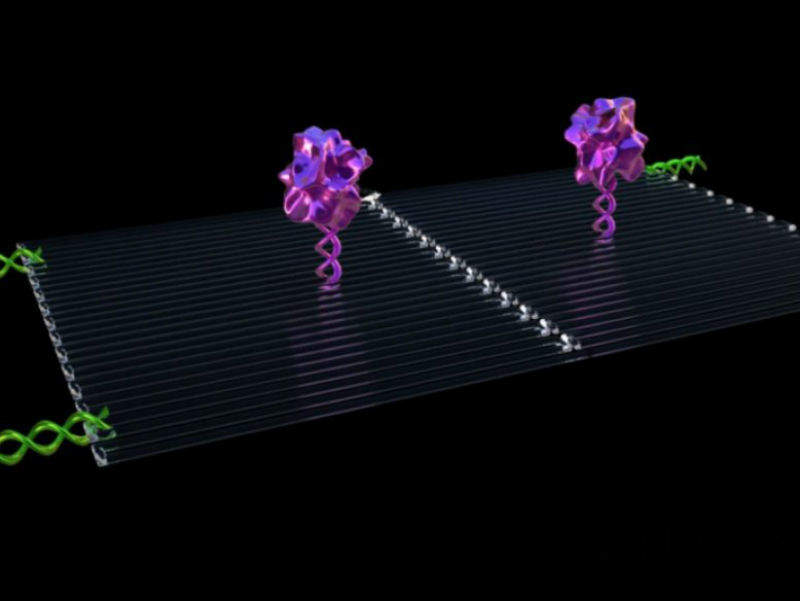
Scientists from Arizona State University (ASU) have successfully programmed nanorobots to shrink tumours by cutting off their blood supply. This study demonstrates the first application of DNA origami for nanomedicine.
The successful demonstration of this technology is the first of its kind in mammals using breast cancer, melanoma, ovarian and lung cancer mouse models. The ASU study was a collaboration with researchers from the National Center for Nanoscience and Technology (NCNST), of the Chinese Academy of Sciences.
Hao Yan, director of the ASU Biodesign Institute’s Center for Molecular Design and Biomimetics and a professor in the School of Molecular Sciences, said: “We have developed the first fully autonomous, DNA robotic system for a very precise drug design and targeted cancer therapy. Moreover, this technology is a strategy that can be used for many types of cancer since all solid tumour-feeding blood vessels are essentially the same.”
Each nanorobot in the study was made from a flat, rectangular DNA origami sheet, 90 nanometres by 60 nanometres in size. Thrombin, a key blood-clotting enzyme, was attached to the surface. It can block tumour blood flow by clotting the blood within the vessels that feed growth, leading to the death of tumour tissue.
Over the past two decades atomic-scale manufacturing has been developed for DNA origami with the aim of building more and more complex structures. The bricks to build the structures come from DNA, which can self-fold into different shapes and sizes.
To perform their study, the scientists used a well-known mouse tumour model, where human cancer cells are injected into a mouse to induce aggressive tumour growth. Once the tumour was growing, the nanorobots were deployed.
How well do you really know your competitors?
Access the most comprehensive Company Profiles on the market, powered by GlobalData. Save hours of research. Gain competitive edge.

Thank you!
Your download email will arrive shortly
Not ready to buy yet? Download a free sample
We are confident about the unique quality of our Company Profiles. However, we want you to make the most beneficial decision for your business, so we offer a free sample that you can download by submitting the below form
By GlobalDataFirst, an average of four thrombin molecules were attached to a flat DNA scaffold. Next, the flat sheet was folded in on itself into a circle to make a hollow tube. This was then injected into a mouse and travelled throughout the bloodstream, heading directly towards the tumours.
The key to programming a nanorobot that only attacks a cancer cell was to include a special payload on its surface, called a DNA aptamer. The DNA aptamer could specifically target the protein nucleolin, which is made in high amounts only on the surface of tumour endothelial cells and not found on the surface of healthy cells.
Once bound to the tumour blood vessel surface, the nanorobot delivered its drug cargo into the very heart of the tumour. The treatment blocked blood supply to the tumour and generated tumour tissue damage within 24 hours while having no effect on healthy tissues. After attacking tumours, most of the nanorobots were cleared and degraded from the body after 24 hours. After two days there was evidence of advanced thrombosis. By day three, thrombi blood clots in all tumour vessels were observed.
Yan added: “The thrombin delivery DNA nanorobot constitutes a major advance in the application of DNA nanotechnology for cancer therapy. In a melanoma mouse model, the nanorobot not only affected the primary tumour but also prevented the formation of metastasis, showing promising therapeutic potential.
“I think we are much closer to real, practical medical applications of the technology. Combinations of different rationally designed nanorobots carrying various agents may help to accomplish the ultimate goal of cancer research: the eradication of solid tumours and vascularised metastases. Furthermore, the current strategy may be developed as a drug delivery platform for the treatment of other diseases by modification of the geometry of the nanostructures, the targeting groups and the loaded cargoes.”
Yan and his collaborators are actively pursuing clinical partners to further develop this technology. The scientists believe that their study is a milestone for nanomedicine.



